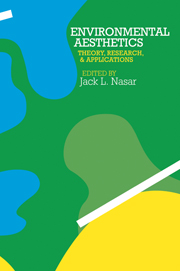Book contents
- Frontmatter
- Contents
- List of figures
- List of tables
- List of contributors and participants
- Acknowledgments
- Preface
- Section I Theory
- Section II Empirical studies
- Editor's introduction
- A Methodological comments
- B Architectural interiors
- C Architectural exteriors
- Editor's introduction
- 14 A study of meaning and architecture
- 15 Predicting user responses to buildings
- 16 Dimensions in the perception of architecture: identification and interpretation of dimensions of similarity
- 17 Contextual compatibility in architecture: an issue of personal taste?
- D Urban scenes
- E Natural and rural scenes
- Section III Applications
- References
- Index of authors
- Subject index
Editor's introduction
Published online by Cambridge University Press: 05 September 2013
- Frontmatter
- Contents
- List of figures
- List of tables
- List of contributors and participants
- Acknowledgments
- Preface
- Section I Theory
- Section II Empirical studies
- Editor's introduction
- A Methodological comments
- B Architectural interiors
- C Architectural exteriors
- Editor's introduction
- 14 A study of meaning and architecture
- 15 Predicting user responses to buildings
- 16 Dimensions in the perception of architecture: identification and interpretation of dimensions of similarity
- 17 Contextual compatibility in architecture: an issue of personal taste?
- D Urban scenes
- E Natural and rural scenes
- Section III Applications
- References
- Index of authors
- Subject index
Summary
The four papers in this section are concerned with the study of the visual quality of architectural exteriors seen alone or in relation to their immediate surroundings. If architects and the public differ in their interpretation of buildings, then design decisions by architects may fail to communicate desirable meanings to the public. Thus the question of similarities and differences between architect and public responses to buildings is an important one. In an early and throrough examination of this question, Hershberger (first paper in this section) documents several important differences in the meanings attributed to buildings by architects (graduating thesis students, undergraduate pre-architecture majors, and undergraduate architecture majors) and laypersons. Notably, the groups differed in assessments of aesthetic quality and Novelty–Excitement. The evident differences between the groups suggest a need for research aimed at informing architects about how the public interprets buildings. Central to such research is the development of an instrument for assessing architectural meaning.
In the second paper, Hershberger and Cass extend Kasmar's lexicon for use in assessing building exteriors. With separate investigations of response to houses, commercial buildings, and institutional buildings, the authors derive a set often factors and related adjective scales (ten primary and ten secondary) for the assessment of architectural exteriors. One can select adjectives representing these factors with some confidence that the adjectives are relevant to the assessment of many exteriors.
- Type
- Chapter
- Information
- Environmental AestheticsTheory, Research, and Application, pp. 173 - 174Publisher: Cambridge University PressPrint publication year: 1988



